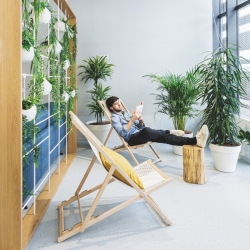April 25, 2024
Office rent, costs and utilisation rates rise as firms focus on prime space
 Prime office rents in major cities around the world have risen 1.1 percent in the past year (Q1 2023 to Q1 2024) while tenants’ ‘all-in’ net effective costs (rent plus fit-out costs) have risen 2.4 percent, according to Savills, as the structural trend towards seeking high quality premium office space continues into 2024.
Prime office rents in major cities around the world have risen 1.1 percent in the past year (Q1 2023 to Q1 2024) while tenants’ ‘all-in’ net effective costs (rent plus fit-out costs) have risen 2.4 percent, according to Savills, as the structural trend towards seeking high quality premium office space continues into 2024.
The real estate advisor says that office utilisation (office occupancy) levels have continued to climb as many companies look to encourage employees’ return to the office by investing in increasing in the quality of the space available to staff.
Office utilisation rates have continued to rise in all the key major regions, Savills says, although there is still a large divide between Asia Pacific locations, which have consistently maintained a strong in-office culture, and Europe and North America, where more flexible working practices have taken root.
This trend is mirrored in costs to prime office occupiers: net effective costs have risen the most in regions where occupancy rates are lowest, as tenants lean towards investing in prime office space to attract employees back and also to meet sustainability requirements. In EMEA and North American markets annual net effective costs have grown on average 4.8 percent and 2 percent respectively year-on-year, reflecting the higher cost of fitting-out buildings in these locations, while in Asia Pacific they have only risen 0.6 percent, although the picture varies quarterly city-by-city.
Savills says the some of the increased cost to occupiers has been off-set by landlord concessions and incentives: general landlord contributions to fit-out costs (excluding turn-key space) are increasing in North American and Europe. Since the first quarter of 2019, the average landlord contribution to fit-out costs has increased by approximately 37.5 percent across the 35 markets Savills monitors. However, it says that this increase is not matching the rise in fit-out costs more broadly, which has resulted in landlord contributions as a percentage of total fit out costs decreasing to 23.4 percent in Q1 2024 compared to 26.8 percent at the beginning of 2019.
Jeremy Bates, EMEA Head of Occupational Markets at Savills, comments: “Landlords are having to work harder to attract and retain tenants, but it’s clear that occupier demand for the best space remains strong even in markets where office utilisation rates may remain below pre-pandemic levels. In some cities, including New York, where supply of prime space remains tight, we’re even seeing landlord concessions beginning to decrease.”
Kelcie Sellers, associate director in Savills World Research team, says: “The potential to achieve higher rents serves as a strong inducement to office landlords to invest and aligns with the projected upwards trend in prime rental growth, even if they have to initially offer incentives to tenants to help them reduce their fit-out costs. However, not all offices will be able to follow this trajectory. While our analysis here concentrates on trends in rents and net effective costs for prime offices, for lower-grade stock, retrofitting to new standards may be prohibitively expensive: offices in less desirable business locations may never attract the tenants – and therefore the rents — to justify the investment. In these cases, repurposing becomes the obvious or only approach, with the range of alternative uses growing around the world: housing, hotels, life sciences and education all feature highly.”


















